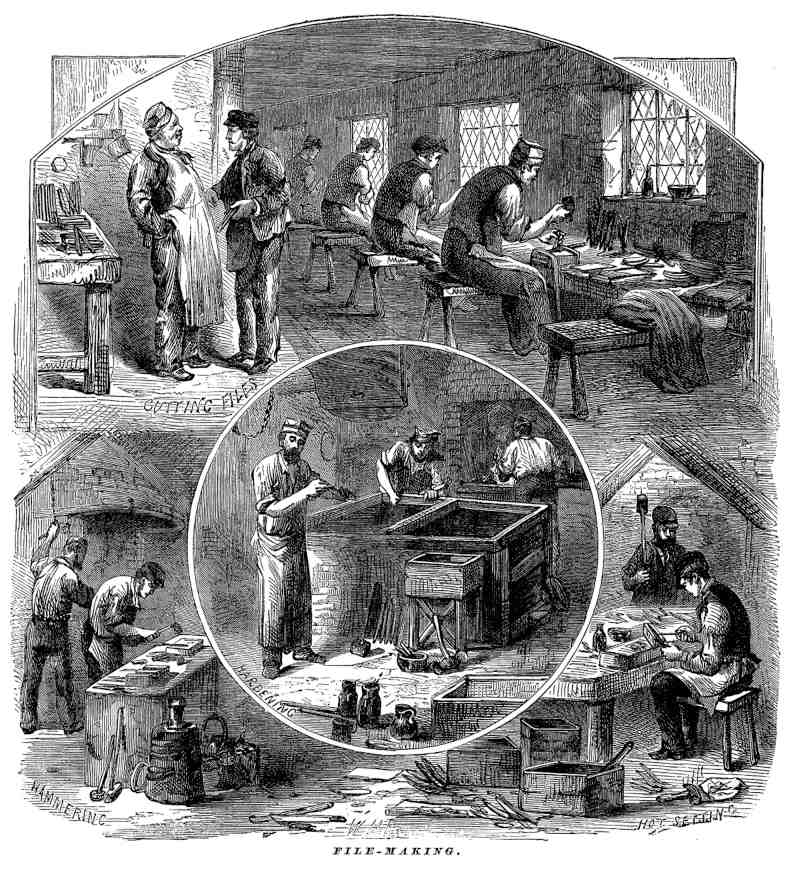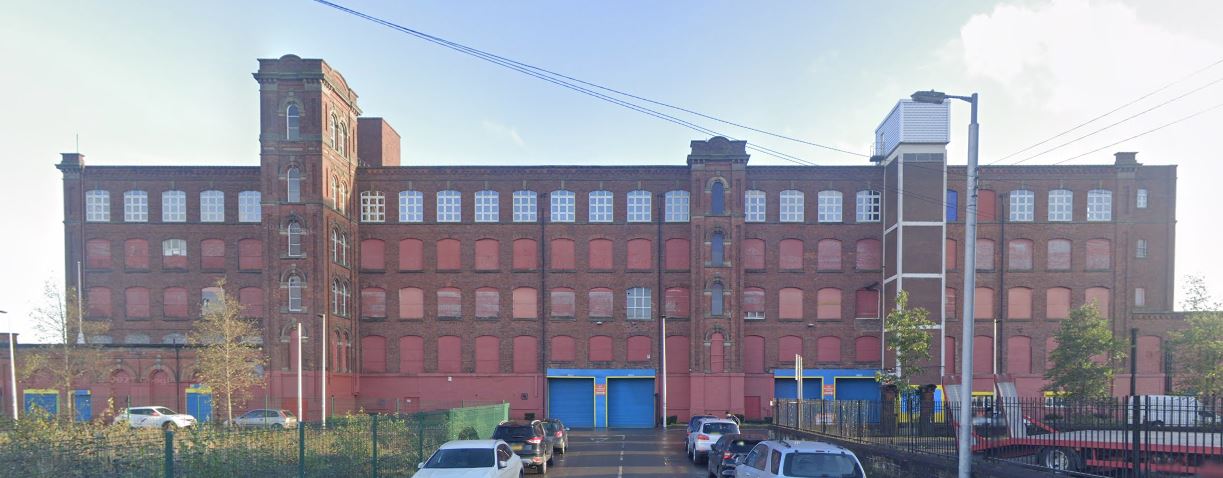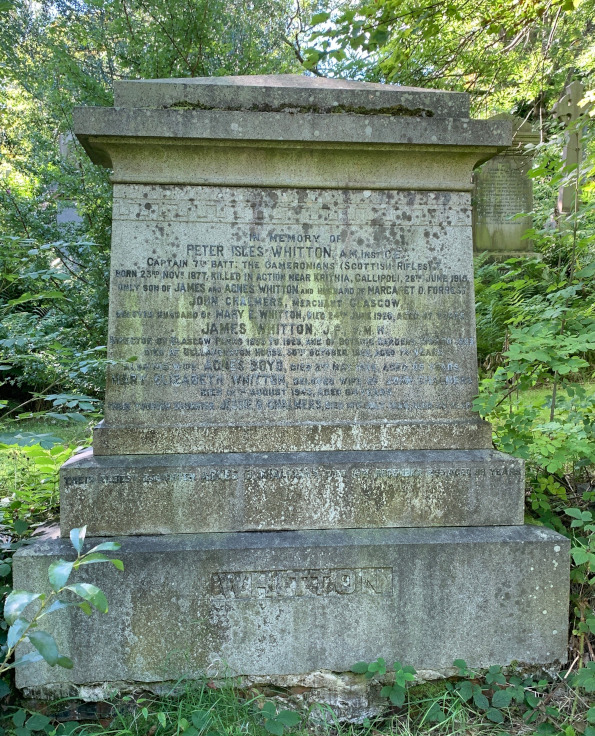Note: This research is based on the people who appear in the Property Database on Bygone Bungo, in this case the entry for 9 Moray Place, which helps give the following context. You can explore further from the Address or Person Search in the main menu.
Thomas Henderson
The first resident of 9 Moray Place was Thomas Henderson, of the Glasgow firm of file manufacturers and steel merchants, M Hetherington & Co, in Dale Street (now Tradeston St), Tradeston. He moved in c.1862 but didn’t stay in Strathbungo more than a couple of years.
John Hetherington
Around 1865-8 the occupant was John Hetherington, of the Glasgow firm of file manufacturers, R Hetherington & Son, of Kingston, not to be confused with previous resident Thomas Henderson of M Hetherington, file manufacturers. Heaven forbid you should confuse them with the Glasgow firm of file manufacturers, J B Hetherington.
Realising there had to be some story here, I embarked on a two-week obsessive detour down some rabbit warren, researching the links between the Hendersons, the Hetheringtons and the history and importance of file-making. Their story features bosses versus unions, men versus machines, family rivalries and alliances, and boom and bust. Sort of the industrial revolution in miniature. But it’s too much for this post; you can read it all under The file-makers of Glasgow.

The art of file-making. Credit: Lost Art Press
Mrs John & William Thomson Henderson
By 1869 the house was occupied by Mrs John Henderson and her son William Henderson, but they thankfully had nothing at all to do with file manufacturing, or the previous John Henderson. The family went on to occupy a number of Strathbungo properties over the years.
This John Henderson was a retired baker from Bo’ness, Scotland, and his wife Margaret and the family appear to have moved to Strathbungo after his death in 1867. William worked as a cashier and book keeper for the Coustonholm Weaving Company, which had an office in town and a factory in Pollokshaws. His mother and sister lived off their annuity, and his younger brother Robert worked as a tweed salesman.
Shortly after the 1871 census, which recorded them at 9 Moray Place, they moved to 3 (now 8) Queen Square. In 1873 William married Georgina Isabella Waddell Cochrane, and by 1881 they were living at Regent Park Terrace on the Pollokshaws Road. Ten years later they owned and lived at 19 Princes Square (now 40 Marywood Square) but at his death in 1921 they were living in Crosshill. One daughter, Mary, married a yarn merchant, one, Margaret, was a spinster, while their son John became a GP in a different Bo’ness, the one in Windermere.
William’s younger brother Robert became a woollen cloth merchant. He lived with his sister Margaret for a while, but later married Margaret Storrar Selkirk, and by 1895 had bought 19 Moray Place, where he and his family still lived at the time of his death in Harrogate in 1907. His wife remained on Moray Place until at least 1920.
Meanwhile William’s sister Margaret took a flat in 14 Regent Park Terrace (848 Pollokshaws Road) from around 1895-1905. Later, around 1915, she was renting at 20 Princes Square (42 Marywood Square) next door to her brother William’s house, although around the same time he moved out to Crosshill.
Dr William Fenwick
William Fenwick (1839-1914) was born in Perth to James Fenwick (b. 1806), a pipe laying supervisor, and Isabella Duff (1824-1910). He was the eldest of 12 children, though there was an unusual gap of 8 years between him and the next child. Given Isabella would have been 15 when he was born, he may have been a child from a previous marriage. By 1861 the family had moved to Glasgow, where he was a medical student. William went on to become a general practitioner.
On 6 Oct 1869 he married Jane Waddell and lived (and possibly practised) at 9 Moray Place from 1871 to around 1886. Jane was the daughter of James Waddell, coalmaster, who in 1871 bought both 9 & 10 Moray Place; he moved into 10 with his family and gave 9 to Jane, his eldest daughter, who moved in with her husband William. In 1881 they were recorded at 10 Moray Place with his parents-in-law, while only their servant, Jessie Algie was at No 9. The couple had no children, and on her early death in 1883, ownership passed to William. He remarried in 1886, to Anne Mary (Hannah Maria) Newsome Murray, and moved to 34 Aytoun Road, with a practice in 17 Bute Terrace (Pollokshaws Road). In the 1891 census the house was empty, bar a servant Jessie McLachlan, who managed to get herself recorded twice, at both 9 and 10. Dr Fenwick was still recorded as the owner in 1905, though renting the property out.
William retired in 1897 to Rome, where he died in 1914. His second wife Hannah died in Rome in 1945. The BMJ published his obituary :
Dr. William Fenwick, who died in Rome on October 25th after a short illness was born in Perth in 1839 and studied medicine at the University of Glasgow, where he took the degree of M.D. in 1864. He was admitted a Fellow of the Faculty of Physicians and Surgeons of Glasgow in 1872. Of the forty-four years during which he was engaged in active professional work, thirty-three were spent in a large general practice in the south side of Glasgow. In 1897 he left Scotland and settled in Rome, where, although he gave up practice six years ago, he remained to the end of his life. While a student he worked in the old Glasgow Infirmary as dresser under Lister, for whom he retained unbounded love and admiration. At the Lister dinner in London in 1907 he and the late Dr. Ramsay occupied the places of honour on Lister’s right and left, being the only survivors of that time who were present. Dr. Fenwick had greatly endeared himself by his kindliness of disposition and genial manner to the British colony in Rome, and he will be much missed on account of the great interest he showed in all matters affecting its welfare, and of the capacity and common sense he always brought to bear on whatever he took in hand. He was a very old member of the British Medical Association. He leaves a widow.
Jane Fenwick, nee Waddell
Jane Fenwick, William’s first wife, was a shareholder in the City of Glasgow Bank when it collapsed spectactularly in 1878 . At the time the bank’s shareholders were subject to unlimited liability – the bank’s failure led to a change in banking law regarding liability – and the bank was short of £6m (1878 prices, perhaps £500m now). Jane had invested £580 and was liable for £2900 (£200,000 now). The vast majority of investors were bankrupted and ruined by the collapse, but it isn’t clear that she was one of them, given she didn’t lose her house. Perhaps her family next door bailed her out as they were proving to be financially very successful at the time, but one wonders if it led to her early death. There is more on the fortunes of the Waddell family in the blog on 10 Moray Place.

The official list of shareholders in the City of Glasgow Bank, liable after its collapse. Credit: Trades House Library

Jane Fenwick’s entry in the book
James Alston Waddell
On William’s death, the Valuation Roll of 1915 records ownership passing to James Alston Waddell, though he was not resident. He is clearly a relative of the Waddell/Alston family next door, but I am unable to identify him, or link him to the family in any way, so he remains a puzzling mystery.
Rev James Cameron
The Rev Cameron was the minister at the Victoria Free Church, and a tenant in 1895. Born at Alyth in 1839, he studied at the University and New College, Edinburgh and was ordained at Collessie, Fife in 1866. He married Helen Gibson Walker in 1867. He moved in 1870 to Pathhead, Kirkaldy, and in 1874 to the Victoria Free Church .
The Victoria Free Church stood at St Andrew’s Cross on Pollokshaws Road & Victoria Road opposite the Star Bar, where the Shell petrol station now stands; the church burnt down in 1929. It is discussed at length on a recent Twitter thread, including newspaper reports of the fire .

The Victoria Free Church at St Andrew’s Cross, with tram procession complete with the stuffed elephant, Sunny Jim. Credit: The Glasgow Story
Thomas Tennant
Thomas Tennant, also a tenant, stayed briefly at 9 Moray Place around 1898-1901. Born in 1851 in East Kilbride, like his father he was a collector of the county rate (taxes) for the county of Lanarkshire. He married Janet, and although he did not have children, his older brother William was a doctor who lived in Kendal, then in Tomintoul, where he died young in 1886, and his daughter Constance was raised by Thomas & Janet. The family later moved to Maxwell Park.
Robert Crawford
Robert Crawford, of Crawford & Eadie, house factors, property valuators & and fire assessors, 58 Bath street, was a tenant of Dr Fenwick around 1902-1905, but later moved to 36 Hamliton Drive in Maxwell Park. He was probably a son of the architect Robert Nicholson Crawford, and may be the one referred to in the practice title of Robert N Crawford & Son. He took over the partnership in Crawford & Eadie house factors, the other partner being David S Eadie, with whom he designed many tenements in Pollokshaws and Shawlands. The practice was known as Robert Crawford & Son in the mid-1920s. He died c.1930 .
Miss Austin
In 1910-11, a Miss Austin was resident, but I know nothing further about her.
Jessie & John Rule
By 1915 the owner was the mysterious James Alston Waddell and the tenant Mrs Jessie Rule, who lived with her husband John of The Glasgow Cotton Spinning Co., Ltd, of Bridgeton. The company’s cotton mill built in 1884 was the largest in Glasgow. The mill closed in 1928, but the building still stands in Dalmarnock, and is listed.

Glasgow Cotton Spinning Company mill, Dalmarnock. Credit: Google Street View
Mrs Mary E Chalmers
By 1920 the house had been sold, and the new owner was Mary Chalmers, nee Whitton. Her husband John ran a creamery in Hospital Street in the Gorbals. He died in 1920, she in 1942, and they are interrred in Craigton cemetery.

Whitton and Chalmers grave, Craigton Cemetery. Credit: Findagrave.com
Additions and corrections are welcome.
References
{3557955:EJHPADT6};{3557955:7QEY4TPE},{3557955:HUN2YDSS};{3557955:2Q3APZBU};{3557955:VJW4XZGX};{3557955:RBRZ7W7T}
vancouver
asc
0
3312
%7B%22status%22%3A%22success%22%2C%22updateneeded%22%3Afalse%2C%22instance%22%3A%22zotpress-e245352575b1e3b9f39095f13450644c%22%2C%22meta%22%3A%7B%22request_last%22%3A0%2C%22request_next%22%3A0%2C%22used_cache%22%3Atrue%7D%2C%22data%22%3A%5B%7B%22key%22%3A%22HUN2YDSS%22%2C%22library%22%3A%7B%22id%22%3A3557955%7D%2C%22meta%22%3A%7B%22parsedDate%22%3A%221878%22%2C%22numChildren%22%3A0%7D%2C%22bib%22%3A%22%3Cdiv%20class%3D%5C%22csl-bib-body%5C%22%20style%3D%5C%22line-height%3A%201.35%3B%20%5C%22%3E%5Cn%20%20%3Cdiv%20class%3D%5C%22csl-entry%5C%22%20style%3D%5C%22clear%3A%20left%3B%20%5C%22%3E%5Cn%20%20%20%20%3Cdiv%20class%3D%5C%22csl-left-margin%5C%22%20style%3D%5C%22float%3A%20left%3B%20padding-right%3A%200.5em%3B%20text-align%3A%20right%3B%20width%3A%201em%3B%5C%22%3E1.%3C%5C%2Fdiv%3E%3Cdiv%20class%3D%5C%22csl-right-inline%5C%22%20style%3D%5C%22margin%3A%200%20.4em%200%201.5em%3B%5C%22%3ECity%20of%20Glasgow%20Bank%3A%20Official%20list%20of%20shareholders%2C%20their%20holdings%20and%20amount%20of%20thier%20calls%20%5BInternet%5D.%20The%20Edinburgh%20Publishing%20Company%3B%201878.%20Available%20from%3A%20%3Ca%20href%3D%27https%3A%5C%2F%5C%2Fwww.tradeshouselibrary.org%5C%2Fuploads%5C%2F4%5C%2F7%5C%2F7%5C%2F2%5C%2F47723681%5C%2Fcity_of_glasgow_bank~_official_list_of_shareholders_and_their_calls_~_1878__002.pdf%27%3Ehttps%3A%5C%2F%5C%2Fwww.tradeshouselibrary.org%5C%2Fuploads%5C%2F4%5C%2F7%5C%2F7%5C%2F2%5C%2F47723681%5C%2Fcity_of_glasgow_bank~_official_list_of_shareholders_and_their_calls_~_1878__002.pdf%3C%5C%2Fa%3E%3C%5C%2Fdiv%3E%5Cn%20%20%3C%5C%2Fdiv%3E%5Cn%3C%5C%2Fdiv%3E%22%2C%22data%22%3A%7B%22itemType%22%3A%22document%22%2C%22title%22%3A%22City%20of%20Glasgow%20Bank%3A%20Official%20list%20of%20shareholders%2C%20their%20holdings%20and%20amount%20of%20thier%20calls%22%2C%22creators%22%3A%5B%5D%2C%22abstractNote%22%3A%22%22%2C%22date%22%3A%221878%22%2C%22language%22%3A%22%22%2C%22url%22%3A%22https%3A%5C%2F%5C%2Fwww.tradeshouselibrary.org%5C%2Fuploads%5C%2F4%5C%2F7%5C%2F7%5C%2F2%5C%2F47723681%5C%2Fcity_of_glasgow_bank~_official_list_of_shareholders_and_their_calls_~_1878__002.pdf%22%2C%22collections%22%3A%5B%22CAR6MXPM%22%5D%2C%22dateModified%22%3A%222022-02-05T19%3A25%3A13Z%22%7D%7D%2C%7B%22key%22%3A%227QEY4TPE%22%2C%22library%22%3A%7B%22id%22%3A3557955%7D%2C%22meta%22%3A%7B%22creatorSummary%22%3A%22Swinfen%22%2C%22parsedDate%22%3A%222016-07-20%22%2C%22numChildren%22%3A1%7D%2C%22bib%22%3A%22%3Cdiv%20class%3D%5C%22csl-bib-body%5C%22%20style%3D%5C%22line-height%3A%201.35%3B%20%5C%22%3E%5Cn%20%20%3Cdiv%20class%3D%5C%22csl-entry%5C%22%20style%3D%5C%22clear%3A%20left%3B%20%5C%22%3E%5Cn%20%20%20%20%3Cdiv%20class%3D%5C%22csl-left-margin%5C%22%20style%3D%5C%22float%3A%20left%3B%20padding-right%3A%200.5em%3B%20text-align%3A%20right%3B%20width%3A%201em%3B%5C%22%3E1.%3C%5C%2Fdiv%3E%3Cdiv%20class%3D%5C%22csl-right-inline%5C%22%20style%3D%5C%22margin%3A%200%20.4em%200%201.5em%3B%5C%22%3ESwinfen%20A.%20The%20History%20Girls%3A%20A%20Victorian%20Scandal%3A%20The%20Failure%20of%20the%20City%20of%20Glasgow%20Bank%20-%20Ann%20Swinfen%20%5BInternet%5D.%20The%20History%20Girls.%202016%20%5Bcited%202022%20Jan%2029%5D.%20Available%20from%3A%20%3Ca%20href%3D%27http%3A%5C%2F%5C%2Fthe-history-girls.blogspot.com%5C%2F2016%5C%2F07%5C%2Fa-victorian-scandal-failure-of-city-of.html%27%3Ehttp%3A%5C%2F%5C%2Fthe-history-girls.blogspot.com%5C%2F2016%5C%2F07%5C%2Fa-victorian-scandal-failure-of-city-of.html%3C%5C%2Fa%3E%3C%5C%2Fdiv%3E%5Cn%20%20%3C%5C%2Fdiv%3E%5Cn%3C%5C%2Fdiv%3E%22%2C%22data%22%3A%7B%22itemType%22%3A%22blogPost%22%2C%22title%22%3A%22The%20History%20Girls%3A%20A%20Victorian%20Scandal%3A%20The%20Failure%20of%20the%20City%20of%20Glasgow%20Bank%20-%20Ann%20Swinfen%22%2C%22creators%22%3A%5B%7B%22creatorType%22%3A%22author%22%2C%22firstName%22%3A%22Ann%22%2C%22lastName%22%3A%22Swinfen%22%7D%5D%2C%22abstractNote%22%3A%22%22%2C%22blogTitle%22%3A%22The%20History%20Girls%22%2C%22date%22%3A%22Wednesday%2C%2020%20July%202016%22%2C%22url%22%3A%22http%3A%5C%2F%5C%2Fthe-history-girls.blogspot.com%5C%2F2016%5C%2F07%5C%2Fa-victorian-scandal-failure-of-city-of.html%22%2C%22language%22%3A%22%22%2C%22collections%22%3A%5B%22CAR6MXPM%22%5D%2C%22dateModified%22%3A%222022-01-29T22%3A43%3A48Z%22%7D%7D%2C%7B%22key%22%3A%22RBRZ7W7T%22%2C%22library%22%3A%7B%22id%22%3A3557955%7D%2C%22meta%22%3A%7B%22numChildren%22%3A1%7D%2C%22bib%22%3A%22%3Cdiv%20class%3D%5C%22csl-bib-body%5C%22%20style%3D%5C%22line-height%3A%201.35%3B%20%5C%22%3E%5Cn%20%20%3Cdiv%20class%3D%5C%22csl-entry%5C%22%20style%3D%5C%22clear%3A%20left%3B%20%5C%22%3E%5Cn%20%20%20%20%3Cdiv%20class%3D%5C%22csl-left-margin%5C%22%20style%3D%5C%22float%3A%20left%3B%20padding-right%3A%200.5em%3B%20text-align%3A%20right%3B%20width%3A%201em%3B%5C%22%3E1.%3C%5C%2Fdiv%3E%3Cdiv%20class%3D%5C%22csl-right-inline%5C%22%20style%3D%5C%22margin%3A%200%20.4em%200%201.5em%3B%5C%22%3EDictionary%20of%20Scottish%20Architects%20-%20Robert%20Crawford%20%5BInternet%5D.%20%5Bcited%202022%20Jan%2029%5D.%20Available%20from%3A%20%3Ca%20href%3D%27http%3A%5C%2F%5C%2Fwww.scottisharchitects.org.uk%5C%2Farchitect_full.php%3Fid%3D206680%27%3Ehttp%3A%5C%2F%5C%2Fwww.scottisharchitects.org.uk%5C%2Farchitect_full.php%3Fid%3D206680%3C%5C%2Fa%3E%3C%5C%2Fdiv%3E%5Cn%20%20%3C%5C%2Fdiv%3E%5Cn%3C%5C%2Fdiv%3E%22%2C%22data%22%3A%7B%22itemType%22%3A%22webpage%22%2C%22title%22%3A%22Dictionary%20of%20Scottish%20Architects%20-%20Robert%20Crawford%22%2C%22creators%22%3A%5B%5D%2C%22abstractNote%22%3A%22%22%2C%22date%22%3A%22%22%2C%22url%22%3A%22http%3A%5C%2F%5C%2Fwww.scottisharchitects.org.uk%5C%2Farchitect_full.php%3Fid%3D206680%22%2C%22language%22%3A%22%22%2C%22collections%22%3A%5B%22CAR6MXPM%22%5D%2C%22dateModified%22%3A%222022-01-29T21%3A25%3A39Z%22%7D%7D%2C%7B%22key%22%3A%22EJHPADT6%22%2C%22library%22%3A%7B%22id%22%3A3557955%7D%2C%22meta%22%3A%7B%22creatorSummary%22%3A%22Group%22%2C%22parsedDate%22%3A%221914-11-21%22%2C%22numChildren%22%3A1%7D%2C%22bib%22%3A%22%3Cdiv%20class%3D%5C%22csl-bib-body%5C%22%20style%3D%5C%22line-height%3A%201.35%3B%20%5C%22%3E%5Cn%20%20%3Cdiv%20class%3D%5C%22csl-entry%5C%22%20style%3D%5C%22clear%3A%20left%3B%20%5C%22%3E%5Cn%20%20%20%20%3Cdiv%20class%3D%5C%22csl-left-margin%5C%22%20style%3D%5C%22float%3A%20left%3B%20padding-right%3A%200.5em%3B%20text-align%3A%20right%3B%20width%3A%201em%3B%5C%22%3E1.%3C%5C%2Fdiv%3E%3Cdiv%20class%3D%5C%22csl-right-inline%5C%22%20style%3D%5C%22margin%3A%200%20.4em%200%201.5em%3B%5C%22%3EGroup%20BMJP.%20Dr.%20William%20Fenwick.%20Br%20Med%20J%20%5BInternet%5D.%201914%20Nov%2021%20%5Bcited%202022%20Jan%2020%5D%3B2%282812%29%3A906%26%23x2013%3B7.%20Available%20from%3A%20%3Ca%20href%3D%27https%3A%5C%2F%5C%2Fwww.bmj.com%5C%2Fcontent%5C%2F2%5C%2F2812%5C%2F906.4%27%3Ehttps%3A%5C%2F%5C%2Fwww.bmj.com%5C%2Fcontent%5C%2F2%5C%2F2812%5C%2F906.4%3C%5C%2Fa%3E%3C%5C%2Fdiv%3E%5Cn%20%20%3C%5C%2Fdiv%3E%5Cn%3C%5C%2Fdiv%3E%22%2C%22data%22%3A%7B%22itemType%22%3A%22journalArticle%22%2C%22title%22%3A%22Dr.%20William%20Fenwick%22%2C%22creators%22%3A%5B%7B%22creatorType%22%3A%22author%22%2C%22firstName%22%3A%22British%20Medical%20Journal%20Publishing%22%2C%22lastName%22%3A%22Group%22%7D%5D%2C%22abstractNote%22%3A%22%22%2C%22date%22%3A%221914%5C%2F11%5C%2F21%22%2C%22language%22%3A%22en%22%2C%22DOI%22%3A%2210.1136%5C%2Fbmj.2.2812.906-c%22%2C%22ISSN%22%3A%220007-1447%2C%201468-5833%22%2C%22url%22%3A%22https%3A%5C%2F%5C%2Fwww.bmj.com%5C%2Fcontent%5C%2F2%5C%2F2812%5C%2F906.4%22%2C%22collections%22%3A%5B%22CAR6MXPM%22%5D%2C%22dateModified%22%3A%222022-01-20T21%3A03%3A59Z%22%7D%7D%2C%7B%22key%22%3A%222Q3APZBU%22%2C%22library%22%3A%7B%22id%22%3A3557955%7D%2C%22meta%22%3A%7B%22numChildren%22%3A1%7D%2C%22bib%22%3A%22%3Cdiv%20class%3D%5C%22csl-bib-body%5C%22%20style%3D%5C%22line-height%3A%201.35%3B%20%5C%22%3E%5Cn%20%20%3Cdiv%20class%3D%5C%22csl-entry%5C%22%20style%3D%5C%22clear%3A%20left%3B%20%5C%22%3E%5Cn%20%20%20%20%3Cdiv%20class%3D%5C%22csl-left-margin%5C%22%20style%3D%5C%22float%3A%20left%3B%20padding-right%3A%200.5em%3B%20text-align%3A%20right%3B%20width%3A%201em%3B%5C%22%3E1.%3C%5C%2Fdiv%3E%3Cdiv%20class%3D%5C%22csl-right-inline%5C%22%20style%3D%5C%22margin%3A%200%20.4em%200%201.5em%3B%5C%22%3EAnnals%20of%20the%20Free%20Church%20%281843-1900%29%2C%20Vol.1%2C%20Ministers%3A%20C%20%5BInternet%5D.%20ecclegen.%20%5Bcited%202022%20Jan%2020%5D.%20Available%20from%3A%20%3Ca%20href%3D%27https%3A%5C%2F%5C%2Fwww.ecclegen.com%5C%2Fministers-c%5C%2F%27%3Ehttps%3A%5C%2F%5C%2Fwww.ecclegen.com%5C%2Fministers-c%5C%2F%3C%5C%2Fa%3E%3C%5C%2Fdiv%3E%5Cn%20%20%3C%5C%2Fdiv%3E%5Cn%3C%5C%2Fdiv%3E%22%2C%22data%22%3A%7B%22itemType%22%3A%22blogPost%22%2C%22title%22%3A%22Annals%20of%20the%20Free%20Church%20%281843-1900%29%2C%20Vol.1%2C%20Ministers%3A%20C%22%2C%22creators%22%3A%5B%5D%2C%22abstractNote%22%3A%22Annals%20of%20the%20Free%20Church%20of%20Scotland%20%281843-1900%29%2C%20Volume%201%2C%20Ewing%2C%20with%20Supplementary%20Material%2C%20Free%20Church%20Ministers%3A%20Cables%20to%20Cusin%22%2C%22blogTitle%22%3A%22ecclegen%22%2C%22date%22%3A%22%22%2C%22url%22%3A%22https%3A%5C%2F%5C%2Fwww.ecclegen.com%5C%2Fministers-c%5C%2F%22%2C%22language%22%3A%22en-GB%22%2C%22collections%22%3A%5B%22CAR6MXPM%22%5D%2C%22dateModified%22%3A%222022-01-20T17%3A11%3A22Z%22%7D%7D%2C%7B%22key%22%3A%22VJW4XZGX%22%2C%22library%22%3A%7B%22id%22%3A3557955%7D%2C%22meta%22%3A%7B%22creatorSummary%22%3A%22New-Cleckit%20Dominie%22%2C%22parsedDate%22%3A%222021-12-27%22%2C%22numChildren%22%3A2%7D%2C%22bib%22%3A%22%3Cdiv%20class%3D%5C%22csl-bib-body%5C%22%20style%3D%5C%22line-height%3A%201.35%3B%20%5C%22%3E%5Cn%20%20%3Cdiv%20class%3D%5C%22csl-entry%5C%22%20style%3D%5C%22clear%3A%20left%3B%20%5C%22%3E%5Cn%20%20%20%20%3Cdiv%20class%3D%5C%22csl-left-margin%5C%22%20style%3D%5C%22float%3A%20left%3B%20padding-right%3A%200.5em%3B%20text-align%3A%20right%3B%20width%3A%201em%3B%5C%22%3E1.%3C%5C%2Fdiv%3E%3Cdiv%20class%3D%5C%22csl-right-inline%5C%22%20style%3D%5C%22margin%3A%200%20.4em%200%201.5em%3B%5C%22%3ENew-Cleckit%20Dominie.%20In%20the%20distance%2C%20you%20can%20make%20out%20the%20tower%20of%20Victoria%20Free%20Church%2C%20which%20stood%20on%20Eglinton%20Toll%2C%20across%20from%20the%20gushet%20building%20that%20now%20houses%20the%20Star%20Bar.%20https%3A%5C%2F%5C%2Ft.co%5C%2FYTVARmwiVc%20%5BInternet%5D.%20%40ncdominie.%202021%20%5Bcited%202022%20Jan%2020%5D.%20Available%20from%3A%20%3Ca%20href%3D%27https%3A%5C%2F%5C%2Ftwitter.com%5C%2Fncdominie%5C%2Fstatus%5C%2F1475511537657946124%27%3Ehttps%3A%5C%2F%5C%2Ftwitter.com%5C%2Fncdominie%5C%2Fstatus%5C%2F1475511537657946124%3C%5C%2Fa%3E%3C%5C%2Fdiv%3E%5Cn%20%20%3C%5C%2Fdiv%3E%5Cn%3C%5C%2Fdiv%3E%22%2C%22data%22%3A%7B%22itemType%22%3A%22blogPost%22%2C%22title%22%3A%22In%20the%20distance%2C%20you%20can%20make%20out%20the%20tower%20of%20Victoria%20Free%20Church%2C%20which%20stood%20on%20Eglinton%20Toll%2C%20across%20from%20the%20gushet%20building%20that%20now%20houses%20the%20Star%20Bar.%20https%3A%5C%2F%5C%2Ft.co%5C%2FYTVARmwiVc%22%2C%22creators%22%3A%5B%7B%22creatorType%22%3A%22author%22%2C%22name%22%3A%22New-Cleckit%20Dominie%22%7D%5D%2C%22abstractNote%22%3A%22%22%2C%22blogTitle%22%3A%22%40ncdominie%22%2C%22date%22%3A%222021-12-27T16%3A58Z%22%2C%22url%22%3A%22https%3A%5C%2F%5C%2Ftwitter.com%5C%2Fncdominie%5C%2Fstatus%5C%2F1475511537657946124%22%2C%22language%22%3A%22en%22%2C%22collections%22%3A%5B%22CAR6MXPM%22%5D%2C%22dateModified%22%3A%222022-01-20T17%3A09%3A45Z%22%7D%7D%5D%7D
1.
New-Cleckit Dominie. In the distance, you can make out the tower of Victoria Free Church, which stood on Eglinton Toll, across from the gushet building that now houses the Star Bar. https://t.co/YTVARmwiVc [Internet]. @ncdominie. 2021 [cited 2022 Jan 20]. Available from:
https://twitter.com/ncdominie/status/1475511537657946124
Like this:
Like Loading...








February 18, 2022 at 5:50 pm
Thoroughly enjoying these articles about the houses in Moray Place. It certainly was a Street that attracted what nowadays would be categorised as “upwardly mobile” families.